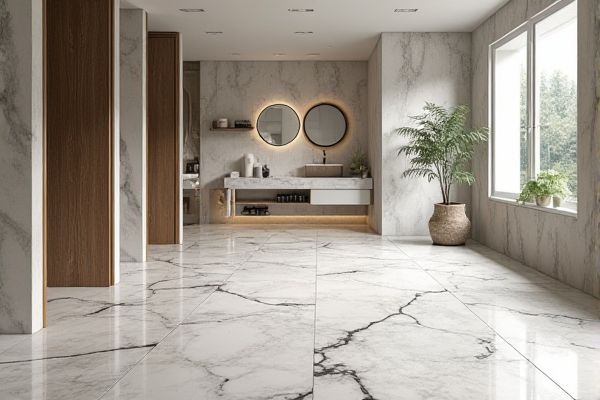
Marble effect tiles mimic the luxurious and natural appearance of marble with easier maintenance and greater durability, while terrazzo tiles feature a composite material of chips embedded in concrete or resin, offering a unique, multicolored pattern and exceptional strength. Discover more about which option suits Your design and functional needs in the rest of the article.
Table of Comparison
| Feature | Marble Effect Tile | Terrazzo Tile |
|---|---|---|
| Material Composition | Porcelain or ceramic with marble-like prints | Composite of marble, quartz, granite chips set in cement or resin |
| Appearance | Realistic marble veining, glossy finish | Speckled, mosaic-like pattern with various stone chips |
| Durability | Highly durable, scratch and stain-resistant | Durable but can be prone to chipping without resin |
| Maintenance | Low maintenance, easy to clean | Requires sealing, moderate maintenance |
| Cost | Moderate, more affordable than real marble | Varies; generally mid-range depending on materials |
| Installation | Standard tile installation; uniform size and shape | Can be customized; more complex installation |
| Common Uses | Flooring, walls, bathrooms, kitchens | Flooring, countertops, decorative surfaces |
Introduction to Marble Effect Tile and Terrazzo Tile
Marble effect tiles replicate the natural veining and luxurious appearance of genuine marble, offering a cost-effective and durable alternative for flooring and wall applications. Terrazzo tiles consist of a composite material with chips of marble, quartz, granite, or glass embedded in a cement or resin binder, known for their unique speckled patterns and high resistance to wear. Both tile types provide stylish and functional solutions in interior design, with marble effect tiles emphasizing elegance and terrazzo tiles delivering a customizable, contemporary aesthetic.
Composition and Manufacturing Process
Marble effect tiles are typically made from porcelain or ceramic, featuring a printed or glazed surface that mimics the natural veining and texture of real marble, using advanced digital printing technology for realistic patterns. Terrazzo tiles consist of a composite material made from chips of marble, quartz, granite, or glass embedded in a cement or epoxy resin binder, which is then cured and polished to create a smooth, durable surface. Your choice between the two should consider that marble effect tiles are manufactured through a printing and firing process for consistent designs, while terrazzo tiles require a labor-intensive casting and polishing procedure, resulting in unique, speckled patterns.
Visual Appeal and Design Versatility
Marble effect tiles feature natural stone patterns with elegant veining that mimic luxurious marble, offering timeless sophistication ideal for traditional and modern interiors. Terrazzo tiles showcase a composite of chips like marble, quartz, and glass embedded in cement or resin, delivering a speckled, colorful surface that emphasizes contemporary and artistic styles. Both tiles provide versatile design options, with marble effect tiles excelling in classic elegance and terrazzo tiles standing out for bold, customizable aesthetics.
Durability and Longevity
Marble effect tiles offer moderate durability with resistance to stains and scratches, but they can chip or crack under heavy impact. Terrazzo tiles are highly durable and long-lasting, consisting of a composite material that blends marble, quartz, and granite chips, providing excellent resistance to wear and heavy foot traffic. Terrazzo's robust composition and maintenance ease make it ideal for high-traffic commercial and residential spaces compared to marble effect tiles.
Installation Process and Requirements
Marble effect tiles offer straightforward installation with standard adhesives and grout, making them suitable for DIY projects and quick setups. Terrazzo tiles require a more precise installation process involving specialized epoxy or cementitious binders and often need professional expertise to ensure durability and proper curing. Your choice impacts the preparation and skill level needed, with terrazzo demanding more careful surface readiness and curing time compared to marble effect tiles.
Maintenance and Cleaning Needs
Marble effect tiles require regular sealing and gentle cleaning with non-acidic products to maintain their polished appearance and prevent staining. Terrazzo tiles offer high durability and low maintenance, needing only routine sweeping and mopping to keep their surface pristine. Your choice between these tiles should consider the effort you're willing to invest in upkeep to preserve their distinctive aesthetic qualities.
Cost Comparison
Marble effect tiles typically cost less than natural marble but can be more expensive than terrazzo tiles, which are made from a composite of marble, quartz, and cement or resin, offering durability at a lower price point. Terrazzo tiles provide excellent value for large areas due to their cost-effectiveness and long lifespan. Your choice depends on balancing budget constraints with desired aesthetics and maintenance requirements.
Sustainability and Eco-Friendliness
Marble effect tiles are typically made from porcelain or ceramic, offering greater durability and lower maintenance while using less natural stone, which reduces quarrying impacts. Terrazzo tiles are composed of recycled materials including glass, marble chips, and cement, making them highly sustainable by repurposing waste and minimizing resource extraction. Your eco-friendly choice depends on prioritizing recycled content with terrazzo or low-impact manufacturing processes found in some marble effect tile options.
Best Applications and Use Cases
Marble effect tiles are ideal for luxurious indoor spaces such as bathrooms, kitchens, and living rooms due to their elegant and timeless appearance paired with ease of maintenance. Terrazzo tiles excel in high-traffic commercial areas, including airports, malls, and office lobbies, thanks to their durability and unique speckled design that hides wear and tear effectively. You can choose marble effect tiles for sophisticated residential aesthetics, while terrazzo tiles are best for practical, modern environments demanding long-lasting performance.
Final Verdict: Which Tile is Right for You?
Marble effect tiles offer luxurious aesthetics and are ideal for spaces requiring a classic, elegant look with low maintenance, while terrazzo tiles provide durability and vibrant, customizable patterns suitable for high-traffic areas. Consider the balance between design preference, budget, and usage needs, as marble effect tiles lean towards sophistication and terrazzo towards practicality and modern versatility. Selecting the right tile depends on prioritizing either timeless beauty or long-lasting performance in your specific environment.
 homyna.com
homyna.com